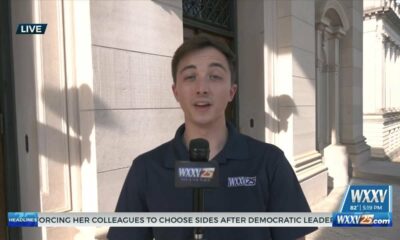Kaiser Health News
Abortion Coverage Is Limited or Unavailable at a Quarter of Large Employers, KFF Survey Finds
Rachana Pradhan
Wed, 18 Oct 2023 09:01:00 +0000
About a quarter of large U.S. employers heavily restrict coverage of legal abortions or don't cover them at all under health plans for their workers, according to the latest employer health benefits survey by KFF.
The findings demonstrate another realm, beyond state laws, in which access to abortion care varies widely across America since the Supreme Court overturned the constitutional right to abortion last year in Dobbs v. Jackson Women's Health Organization.
More than ever, where someone works and the constraints of their health insurance can determine whether an abortion is possible. Workers without coverage are left to pay out-of-pocket for abortion care and related costs.
In 2021, the median costs for people paying out-of-pocket in the first trimester were $568 for a medication abortion and $625 for an abortion procedure, according to a report from Advancing New Standards in Reproductive Health at the University of California-San Francisco. By the second trimester, the cost increased to $775 for abortion procedures.
KFF's 2023 annual survey found that 10% of large employers — defined as those with at least 200 workers — don't cover legal abortion care under their largest job-based health plan. An additional 18% said legal abortions are covered only in limited circumstances, such as when a pregnancy is the result of rape or incest, or endangers a person's life or health.
The share of employers that said they don't cover abortion under any circumstances “is bigger than I would have expected,” said Matthew Rae, an associate director at KFF who helped conduct the survey.
So far, 14 states, mostly in the South and Midwest, have enacted near-total abortion bans, and an additional seven states have instituted gestational limits between six and 18 weeks. Abortion is legal in 24 states and the District of Columbia.
Sharply divergent state abortion laws solidified in the aftermath of the Dobbs decision compound the complexity for employers with workers across multiple states, Rae said. Many large companies employ people in places with vastly different abortion policies, and their health benefits are more likely to cover dependents who may live elsewhere.
“Those dependents can be college kids — and college kids can be anywhere — or any other type of dependent who could just spread out over an area much larger than where you just have actual physical establishments,” Rae said.
The KFF survey found that about a third of large companies said they cover legal abortions in most or all circumstances; the largest companies, with at least 5,000 employees, were more likely to offer the benefit compared with smaller firms. An additional 40% said they were unsure of their coverage — perhaps because employer policies are in flux, Rae said.
Employer health plans' treatment of abortion has changed little since the Dobbs decision, the survey found. Among companies that said they did not cover legally provided abortion services or covered them in limited circumstances, 3% reduced or eliminated abortion coverage. By contrast, of the large companies that generally covered abortion, 12% added or significantly expanded coverage.
That's in sharp contrast to the rapidly changing laws governing abortion access in the states. It's unclear whether workers at companies that don't cover abortion or heavily restrict coverage are located primarily in states that have outlawed the procedure.
The KFF survey includes information from more than 2,100 large and small companies on their health benefits and the related costs for workers. Annual premiums for family coverage rose 7% on average this year, to $23,968, with employees on average contributing $6,575 toward that cost. The jump in premiums represents a notable increase compared with that of the previous year, when there was virtually no growth in those costs. Average yearly deductibles for workers were $1,735 for single coverage, a cost that was relatively unchanged.
One tactic employers use is to provide separate benefits for abortion-related expenses. In response to increasingly restrictive state abortion laws and the Supreme Court's decision, large companies — such as Amazon, Starbucks, Disney, Meta, and JPMorgan Chase, among others — announced they would pay for employees' abortion-related travel expenses.
However, the KFF survey found that a small share of large employers said they provide or plan to provide workers with financial help to cover abortion-related travel expenses. Companies with at least 5,000 workers are the most likely to provide that assistance. Overall, 7% of large employers said they provide or plan to provide financial assistance to employees who must travel out of state for abortion care.
According to the Brigid Alliance, a New York-based nonprofit that helps people with logistics and defrays abortion-related costs, average travel costs now exceed $2,300. As restrictive laws proliferate, distances traveled have also increased since the Dobbs ruling, with each person on average traveling roughly 1,300 miles round trip in the first half of 2023.
Recent research published by job-search firm Indeed, the Institute of Labor Economics, and academics from the University of Southern California and the University of Maryland found that employers that announced abortion-related travel benefits saw an 8% increase in clicks on their job postings compared with similar jobs at comparable employers that did not announce such a policy.
However, job satisfaction among existing employees also dropped at those companies, with ratings of senior management dropping “8%, driven by workers in typically male-dominated jobs,” they wrote, “illustrating both the potential perks and pitfalls for companies that choose to wade into contentious political waters.”
——————————
By: Rachana Pradhan
Title: Abortion Coverage Is Limited or Unavailable at a Quarter of Large Employers, KFF Survey Finds
Sourced From: kffhealthnews.org/news/article/abortion-coverage-kff-employer-survey/
Published Date: Wed, 18 Oct 2023 09:01:00 +0000
Did you miss our previous article…
https://www.biloxinewsevents.com/pregnant-and-addicted-homeless-women-see-hope-in-street-medicine/
Kaiser Health News
DIY Gel Manicures May Harm Your Health
Tarena Lofton
Thu, 02 May 2024 09:00:00 +0000
A fresh set from the comfort of your own home? DIY gel nails have been all the rage on social media, but the practice could cause you to develop a life-changing allergy. In a TikTok video, creator @alina.gene describes developing an acrylate allergy from doing gel nails at home. Now, when exposed to acrylates, the creator feels severe pain.
The creator warns viewers not to self-apply nail polish that requires a UV light to cure. In later videos, @alina.gene explains that at-home use differs from in-salon use because salon professionals have access to higher-quality chemicals that are less likely to cause reactions and that they also have proper training on how to safely apply the products.
“I know I sound real dramatic because an allergy to gel nails or even an allergy to acrylates isn't going to kill you, but the thing is, in the wrong situation it could prevent you from getting lifesaving medical care,” said @alina.gene in another video. Common medical products contain acrylates, and developing this allergy can cause major issues in obtaining future medical care.
We asked an allergist to walk us through this viral video.
If you enjoyed this story from the KFF Health News social team, follow us on Instagram @KFFHealthNews.
✍️: KFF Health News Audience Engagement Team
——————————
By: Tarena Lofton
Title: DIY Gel Manicures May Harm Your Health
Sourced From: kffhealthnews.org/news/article/diy-gel-manicures-health-risks/
Published Date: Thu, 02 May 2024 09:00:00 +0000
Did you miss our previous article…
https://www.biloxinewsevents.com/robert-f-kennedy-jr-is-wrong-about-a-ban-on-nih-research-about-mass-shootings/
Kaiser Health News
Robert F. Kennedy Jr. Is Wrong About a Ban on NIH Research About Mass Shootings
Louis Jacobson, PolitiFact
Thu, 02 May 2024 09:00:00 +0000
“Congress prohibits the NIH from researching the cause of mass shootings.”
Robert F. Kennedy Jr. in an April 21 post on X
The National Institutes of Health is the federal government's main agency for supporting medical research. Is it barred from researching mass shootings? That's what presidential candidate Robert F. Kennedy Jr. said recently.
Kennedy, whose statements about conspiracy theories earned him PolitiFact's 2023 “Lie of the Year,” is running as an independent third-party candidate against President Joe Biden, the presumptive Democratic candidate, and the presumptive Republican nominee, former President Donald Trump.
On April 21 on X, Kennedy flagged his recent interview with conservative commentator Glenn Beck, which touched on gun policy. Kennedy summarized his gun policy views in the post, writing, “The National Institutes of Health refuses to investigate the mystery; in fact, Congress prohibits the NIH from researching the cause of mass shootings. Under my administration, that rule ends — and our kids' safety becomes a top priority.”
But this information is outdated.
In 1996, Congress passed the “Dickey Amendment,” an appropriations bill provision that federal officials widely interpreted as barring federally funded research related to gun violence (though some observers say this was a misinterpretation). Congress in 2018 clarified that the provision didn't bar federally funded gun-related research, and funding for such efforts has been flowing since 2020.
Kennedy's campaign did not provide evidence to support his statement.
What Was the Dickey Amendment?
After criticizing some federally funded research papers on firearms in the mid-1990s, pro-gun advocates, including the National Rifle Association, lobbied to halt federal government funding for gun violence research.
In 1996, Congress approved appropriations bill language saying that “none of the funds made available for injury prevention and control at the Centers for Disease Control and Prevention may be used to advocate or promote gun control.” The language was named for one of its backers, Rep. Jay Dickey (R-Ark).
But the Dickey Amendment, as written, did not ban all gun-related research outright.
“Any honest research that was not rigged to produce results that helped promote gun control could be funded by CDC,” said Gary Kleck, a Florida State University criminologist. But CDC officials, experts said, interpreted the Dickey Amendment as banning all gun-related research funding.
This perception meant the amendment “had a chilling effect on funding for gun research,” said Allen Rostron, a University of Missouri-Kansas City law professor who has written about the amendment. Federal agencies “did not want to take a chance on funding research that might be seen as violating the restriction” and so “essentially were not funding research on gun violence.”
Also, the Dickey Amendment targeted only the CDC, not all other federal agencies. Congress expanded the restriction to cover NIH-funded research in 2011.
Although the Dickey Amendment didn't bar gun-related research, federal decision-makers acted as though it did by not pursuing such research.
Moving Past the Dickey Amendment
Over time, critics of the gun industry made an issue of the Dickey Amendment and gathered congressional support to clarify the amendment.
In 2018, lawmakers approved language that said the amendment wasn't a blanket ban on federally funded gun violence research. By 2020, federal research grants on firearms began to be issued again, starting with $25 million to be split between the CDC and NIH.
By now, the CDC and NIH are funding a “large portfolio” of firearm violence-related research, said Daniel Webster, a professor at the Johns Hopkins Bloomberg School of Public Health.
Also, the Justice Department's National Institute of Justice has funded the largest study of mass shootings to date, Webster said, and is seeking applications for studies of mass shootings.
Our Ruling
Kennedy said, “Congress prohibits the NIH from researching the cause of mass shootings.”
Although the Dickey Amendment, a provision of appropriations law supported by the gun industry, didn't prohibit all federally supported, gun-related research from 1996 to 2018, decision-makers acted as though it did.
However, in 2018, Congress clarified the provision's language. And since 2020, CDC, NIH, and other federal agencies have funded millions of dollars in gun-related research, including studies on mass shootings.
We rate Kennedy's statement False.
Our Sources
Robert F. Kennedy Jr. post on X, April 21, 2024
National Institutes of Health, “NIH Awards Additional Research and Training Grants to Support Firearm Injury and Mortality Prevention Science,” Sept. 20, 2023
National Institute of Justice, “Public Mass Shootings: Database Amasses Details of a Half Century of U.S. Mass Shootings with Firearms, Generating Psychosocial Histories,” Feb. 3, 2022
National Institute of Justice, “NIJ FY24 Research and Evaluation on Firearm Violence and Mass Shootings,” Feb. 5, 2024
Centers for Disease Control and Prevention, “Funded Research,” accessed April 22, 2024
American Psychological Association, “A Thaw in the Freeze on Federal Funding for Gun Violence and Injury Prevention Research,” April 1, 2021
Allen Rostron, “The Dickey Amendment on Federal Funding for Research on Gun Violence: A Legal Dissection” (American Journal of Public Health), July 2018
Email interview with Gary Kleck, a Florida State University criminologist, April 22, 2024
Email interview with Daniel W. Webster, professor at the Johns Hopkins Bloomberg School of Public Health, April 22, 2024
Email interview with Jaclyn Schildkraut, executive director of the Regional Gun Violence Research Consortium at the Rockefeller Institute of Government, April 22, 2024
Email interview with Mike Lawlor, University of New Haven criminologist, April 22, 2024
Email interview with Allen Rostron, University of Missouri-Kansas City law professor, April 22, 2024
KFF Health News is a national newsroom that produces in-depth journalism about health issues and is one of the core operating programs at KFF—an independent source of health policy research, polling, and journalism. Learn more about KFF.
USE OUR CONTENT
This story can be republished for free (details).
——————————
By: Louis Jacobson, PolitiFact
Title: Robert F. Kennedy Jr. Is Wrong About a Ban on NIH Research About Mass Shootings
Sourced From: kffhealthnews.org/news/article/fact-check-rfk-jr-wrong-nih-research-mass-shootings-gun-control-dickey-amendment/
Published Date: Thu, 02 May 2024 09:00:00 +0000
Did you miss our previous article…
https://www.biloxinewsevents.com/breaking-a-promise-california-deficit-could-halt-raises-for-disability-workers/
Kaiser Health News
‘Breaking a Promise’: California Deficit Could Halt Raises for Disability Workers
Vanessa G. Sánchez
Thu, 02 May 2024 09:00:00 +0000
SACRAMENTO, Calif. — Families of people with intellectual and developmental disabilities say Gov. Gavin Newsom is reneging on a scheduled raise for the workers who care for their loved ones, and advocates warn of potential lawsuits if disability services become harder to get.
Citing California's budget deficit, the Democratic governor wants to save around $613 million in state funds by delaying pay increases for a year for about 150,000 disability care workers. The state will forgo an additional $408 million in Medicaid reimbursements, reducing funding by over $1 billion.
Some lawmakers say this decision will increase staff turnover and vacancies, leaving thousands of children and adults with disabilities without critical services at home and in residential facilities. Disability advocates warn it could violate the Lanterman Act, California's landmark law that says the state must provide services and resources to people with disabilities and their families.
Newsom is “breaking a promise,” said Felisa Strickland, 60, who has been searching for more than a year for a day program for her 23-year-old daughter, Lily, who has autism and cerebral palsy. “It's creating a lot of physical and mental health problems for people, and it's a lot of undue stress on aging parent caregivers like myself.”
Disability care workers, known as direct support professionals, provide daily, hands-on caregiving to help children and adults with intellectual and developmental disabilities, such as autism, cerebral palsy, and epilepsy, remain independent and integrated into their communities.
In California, more than 400,000 people with disabilities need accommodation, and this population, along with seniors, is increasing. It's not clear how big the worker shortage is because the state hasn't released workforce data. As the demand for these workers grows generally, experts predict a shortage of between 600,000 and 3.2 million direct care workers by 2030.
Advocates say California pays most providers from $16 to $20 an hour, which meets the state's minimum wage but falls short of what some economists consider a living wage. In 2021, the state committed to raising wages after identifying a $1.8 billion gap between the rates received by nonprofits that contract with the state to provide care and the rates deemed adequate.
Thus far, the state has provided around half that total, most of which has gone to raising wages and benefits. Workers had been expecting one more increase, of $2-$4 an hour, in July, until Newsom proposed a delay.
Also, nonprofits say California has made it harder to compete for workers after raising wages in other service and health industries. Newsom approved a $20 minimum wage for fast-food workers that went into effect in April and he struck a deal last year with unions and hospitals to begin raising health care workers' wages to a minimum of $25 an hour.
Ricardo Zegri said Taco Bell would pay him more than the $19 an hour he makes as a disability care worker in a supervisory position.
“Every paycheck, it's a discussion at home about what bills we need to prioritize and whether it's time to start looking for work that pays more,” said Zegri, who works a second job as a musician in the San Francisco Bay Area.
Newsom wants to preserve key health initiatives, including the state expansion of Medi-Cal to low-income immigrants regardless of legal status, and CalAIM, an ambitious $12 billion experiment to transform Medi-Cal into both a health insurer and a social services provider. However, the rate delay for providing disability care is the largest savings in the Health and Human Services budget as Newsom and legislative leaders look to cuts, delays, and shifts in funding to close a deficit estimated between $38 billion and $73 billion.
Dozens of legislators from both parties are asking Newsom and legislative leaders to preserve the increase. Assembly member Stephanie Nguyen, a Democrat from Elk Grove, signed a letter supporting the raise. Although lawmakers are negotiating with the administration, she said reversing the decision to delay the pay boost is unlikely. Everybody “has to take a hit somewhere,” Nguyen said.
Krystyne McComb, a spokesperson for the Department of Developmental Services, said even though the state would lose federal matching funds this year, it would resume drawing funds when the state reinstates the plan in 2025.
The department did not respond to questions about how it plans to retain workers and fill vacancies.
Newsom's proposal risks a collapse of the disability service system, which would violate the Lanterman Act and make the state vulnerable to lawsuits, said Jordan Lindsey, executive director of the Arc of California, a statewide disability rights advocacy organization.
Families say the state has already fallen short on services they need. Strickland quit her job to care for Lily, the Santa Barbara mother said. “It's not reasonable to expect someone to care for somebody else 24 hours a day, seven days a week,” she said.
Lily graduated from high school and in 2022 completed a program that prepares youth with disabilities to transition into adult life. She had been looking forward to joining a day program to make new friends but has yet to find a spot. And due to a shortage of workers, Lily receives only four hours a week at home with a provider, who is paid around $16 an hour.
When Lily hangs out with the provider, her demeanor changes to the happy person she used to be, Strickland said.
“The system is already in crisis,” she said. “There are tons and tons of people that are sitting at home because there's nowhere for them to go.”
——————————
By: Vanessa G. Sánchez
Title: ‘Breaking a Promise': California Deficit Could Halt Raises for Disability Workers
Sourced From: kffhealthnews.org/news/article/california-disability-worker-pay-delay-deficit/
Published Date: Thu, 02 May 2024 09:00:00 +0000
-
Mississippi Today4 days ago
On this day in 1951
-
Mississippi News5 days ago
One injured in Mississippi officer-involved shooting after chase
-
SuperTalk FM3 days ago
Festival merger in Leland sets up one major event for Mississippi Delta
-
Mississippi News2 days ago
Two women accused of shoplifting across southeast captured in Mississippi
-
SuperTalk FM3 days ago
PERS bill set to phase in employer rate increase heads to governor’s desk
-
Mississippi Business1 day ago
Geartek expanding operations in Alcorn County
-
Mississippi News Video7 days ago
Vehicle fire blocks all lanes of I-55 South in Hinds County
-
SuperTalk FM6 days ago
Investigation underway after gun found in backpack of Ridgeland High School student








































